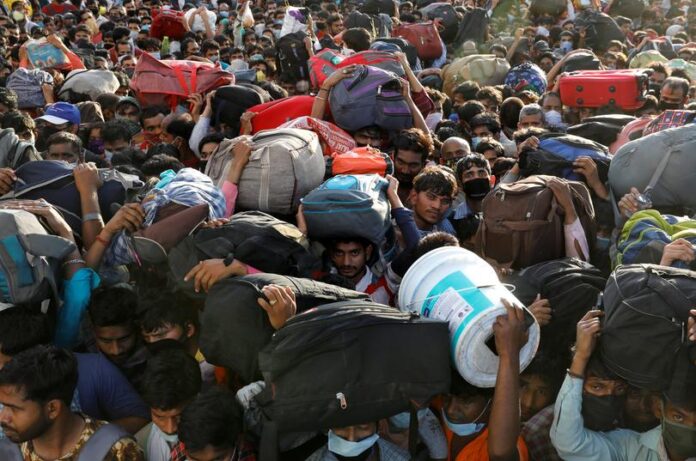| Subscribe to our YouTubeChannel |
|
|---|
On Monday, a senior Indian government official told journalists that there was no oxygen shortage in Delhi or elsewhere in the country.
Several small hospitals a few miles from where he stood in the capital were sending out desperate messages about running out of oxygen, putting patients’ lives in jeopardy as he spoke.
Because of the risk of children dying, the chief doctor of one of the hospitals, a specialist paediatric facility, told the BBC that “our hearts were in our mouths.” After a local politician intervened, they were able to get supplies just in time.
Despite this, the federal government has insisted there was no shortage. “The only issue we have is transportation,” said Piyush Goyal, a senior official in India’s home ministry.
Indeed, hospitals must “ensure judicious use of oxygen in accordance with the guidelines,” Mr. Goyal continued, perplexing doctors.
However, experts say that the lack of oxygen is just one of the issues that show the Indian government was “caught sleeping at the wheel,” failing to do enough to prevent or mitigate the second wave’s damage.
In fact, numerous warnings have been issued, including:
A parliamentary standing committee on health reported in November that there was a shortage of oxygen and “grossly inadequate” government hospital beds.
Several experts told the BBC in February that they were concerned about an impending “Covid tsunami.”
The government formed an expert group of scientists in early March to warn officials about a more contagious variant of coronavirus spreading in the country, but no significant containment measures were taken, according to one scientist from the group. The government has yet to respond to the allegations.
Despite this, India’s health minister declared on March 8 that the pandemic was nearing its end.
So, what went wrong?
the fundamentals
The number of daily cases in the United States fell to under 20,000 in January and February, down from around 90,000 in September of last year. Prime Minister Narendra Modi declared Covid defeated and ordered all public gathering places to be opened.
And, thanks in part to muddled messaging from the top, people began to disregard Covid safety protocols.
While Mr. Modi encouraged people to wear masks and maintain social distance in his public messages, he spoke to large crowds of people who were not wearing masks during his election campaigns in five states. A number of his ministers have also been seen speaking to large crowds without masks. The Kumbh Mela, a Hindu festival that draws millions of people, was also allowed to take place.
“There was a complete disconnect between what they practised and what they preached,” says Dr. Chandrakant Lahariya, a public policy and health systems expert.
“The government simply did not see the second wave coming and began celebrating too soon,” says prominent virologist Dr. Shahid Jameel.
But there’s more to the story: the disaster has revealed India’s public healthcare system’s underfunding and neglect.
Outside hospitals, heartbreaking scenes of people dying without treatment have been witnessed, revealing the grim reality of India’s healthcare infrastructure.
According to one expert, India’s “public health infrastructure has always been broken, and the rich and middle classes are only now discovering it.” The wealthy have always relied on private hospitals for treatment, while the poor struggle to even get a doctor’s appointment.
Recent initiatives, such as health insurance and low-cost medicines for the poor, are failing to help because little has been done in decades to increase the number of doctors and hospitals.
For the past six years, India’s healthcare spending, both private and public, has been around 3.6 percent of GDP, the lowest among the five Brics countries: Brazil spent the most at 9.2 percent in 2018, followed by South Africa at 8.1 percent, Russia at 5.3 percent, and China at 5 percent.
The United States, for example, spent 16.9% of GDP on health in 2018, while Germany spent 11.2 percent. Sri Lanka (3.76%) and Thailand (3.79%) spend more than India.
Getting ready
Last year, several “empowered committees” looked into the preparations needed to combat the next coronavirus wave, so experts are perplexed by the oxygen, bed, and drug shortages.
“They should have prepared for a second wave and assumed the worst when the first wave was tapering. They should have stocked up on oxygen and [the drug] remdesivir before ramping up production capacity “Former Maharashtra state health secretary Mahesh Zagade told the BBC.
Officials claim that India produces enough oxygen to meet the surge in demand, but that transportation was the issue – a claim that experts dispute.
After many patients died due to a lack of oxygen, the government is now running special trains carrying oxygen from one state to another and prohibiting the use of oxygen in industries.
Kerala, on the other hand, had anticipated the surge and had prepared ahead of time. Dr. A Fathahudeen, a member of the state’s Covid taskforce, claims that there was no oxygen shortage in the state because necessary steps were taken in October of last year.
“We also purchased enough remdesivir, tocilizumab, and other drugs well ahead of time. We also have a backup plan in place in case the number of people increases dramatically in the coming weeks “he declares
Mr. Zagade believes that other countries should have taken similar measures “to avoid the suffering.”
“Learning means someone else has done it before you and you can do it now, but it will take time,” the former Maharashtra health secretary explained.
However, time is running out, as the second wave is now reaching villages where healthcare systems are unprepared to handle the influx.

















